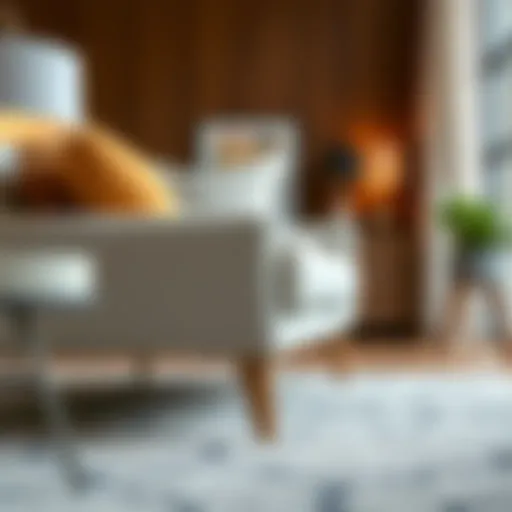Diverse Styles of Floor Lamp Shades for Your Home
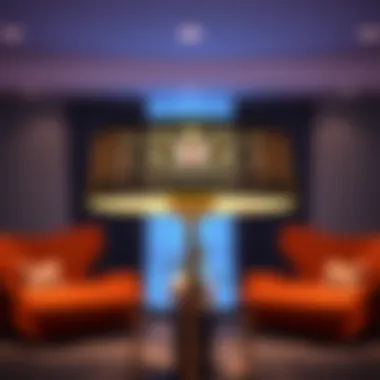

Intro
In the world of interior design, light floor lamp shades play a pivotal role in setting the tone of a space. Whether you're revamping an old room or starting from scratch, the right shade can add warmth, character, and style to any environment. Homeowners and design aficionados alike often overlook the diversity present in lamp shades, which ranges from classical materials to contemporary designs. Choosing the right lamp shade isn’t merely about aesthetics; it’s about functionality and enhancing the overall ambiance.
Understanding the various styles, materials, and designs that floor lamp shades encompass equips individuals with valuable insights that influence their selections. This exploration leads to informed decisions that align with one’s personal taste while fulfilling practical lighting requirements. Readers will gain an appreciation for how these elements interact within the realm of home decor, guiding them to thoughtfully integrate lighting solutions that resonate with their lifestyle.
Furniture Styles and Trends
Exploring Popular Furniture Styles
When it comes to designing a living space, selecting the fitting furniture style sets the stage for everything that comes afterward. The furniture not only serves practical purposes but also reflects the homeowner’s personality. In recent years, various styles have gained traction that influence floor lamp design.
- Mid-Century Modern: This style is known for its sleek lines and organic shapes. Light fixtures that complement this aesthetic, often using simple shades made from materials like cotton or linen, help maintain a clean look.
- Scandinavian: Characterized by minimalism and functionality, Scandinavian styles typically utilize neutral colors. Lamp shades crafted from natural materials enhance the airy feel of these environments.
- Industrial: A style that embraces raw materials, industrial decor can pair beautifully with metal lamp shades that add character without overwhelming the space.
- Bohemian: For the free spirits, bohemian decor favors vibrant colors and patterns. Textured or patterned lamp shades can punctuate the space, infusing it with a sense of whimsy.
Understanding Current Design Trends
Keeping an eye on the current trends can also guide homeowners in selecting appropriate lamp shades for their interiors. Recent trends often revolve around:
- Eco-Friendly Materials: Sustainability is no longer a passing fad. Many lamp shades are being designed with reclaimed materials or certified bamboo, appealing to the environmentally-conscious consumer.
- Bold Colors and Patterns: Gone are the days of muted tones; colorful lamp shades are making a resurgence, allowing homeowners to make a statement without compromising functionality.
- Smart Lighting: As technology advances, smart lamps and shades allow for tailored ambiance, enabling users to adjust brightness or color via apps.
"Floor lamp shades can greatly influence the emotional tone of a space, making them a crucial element in interior design."
Practical Tips for Furniture Selection
Factors to Consider When Choosing Furniture
Making educated choices when selecting furniture—especially in terms of lamp shades—can contribute significantly to the harmonious balance in a room. Several factors to keep in mind include:
- Scale and Proportion: The size of the lamp shade should be proportionate to the floor lamp and the room itself. A large shade can overwhelm a small space, while a tiny shade may seem lost in a larger area.
- Color Palette: Consider the existing color scheme when choosing a shade. Shades that harmonize with the room’s palette create a unified look, while contrasting colors can serve as eye-catching focal points.
- Lighting Needs: Think about the purpose of the lamp. If it’s for reading, opt for a shade that allows more light to filter through. For ambiance, a diffusing shade can create a soft glow.
How to Measure and Optimize Space
Optimizing space in your living area while incorporating floor lamps requires a bit of strategy. Here are practical steps to follow:
- Take Measurements: Before shopping for a lamp shade, measure the height and width of your spaces. Consider not just the floor area but also sightlines to ensure scale is appropriate.
- Experiment with Placement: Use painter’s tape to outline where the lamp might go. This technique helps visualize its impact on existing furniture arrangement before making a purchase.
- Consider Functionality: Make sure the lamp shade allows for enough light and fits the room's uses. A common mistake is to choose looks over practicality.
By understanding the diversity of light floor lamp shades and recognizing the interplay between styles, design trends, and practical considerations, readers will be well on their way to enhancing their living spaces. This article promises to unravel the vast array of choices available, enabling informed decisions that enrich home decor.
Understanding Light Floor Lamp Shades
When delving into the realm of interior lighting, floor lamp shades often occupy a crucial yet overlooked role. They are not merely functional accessories but are vital components that can dramatically influence the atmosphere and aesthetic of any space. The variety of styles, materials, and designs available today allows homeowners and designers alike to tailor their lighting choices to suit individual tastes and functional needs. This pay-off goes far beyond just light; it encompasses mood, style, and even safety.
Definition and Purpose
Light floor lamp shades serve several key purposes. At their core, they are designed to diffuse and direct light efficiently. By choosing the right shade, you can control how bright or soft the light appears in your room. For instance, a fabric shade might soften the light, rendering it more inviting, while a glass shade can project brighter and clearer illumination.
Additionally, lamp shades help to protect the light bulb, preventing dust accumulation and reducing exposure to heat. Not only do they enhance functionality, but they also play a significant role in home decor. A well-chosen lamp shade can transform a mundane floor lamp into a statement piece, tying together the different elements of a room's design.
Historical Background
The evolution of lamp shades reflects broader trends in home decor and design aesthetics. Historically, lamp shades can be traced back to the early 19th century when they were primarily utilitarian - aimed at shielding the eyes from harsh light. Early designs often consisted of simple fabrics stretched over a frame, intended to soften the glow of oil lamps.
As time progressed, innovation and artistic expression began to permeate the design of lamp shades. By the early 20th century, the Art Nouveau and Art Deco movements embraced bolder aesthetic choices. Glass shades with intricate patterns and vibrant colors became all the rage, allowing homeowners to personalize their spaces far more than earlier generations could.
Fast forward to today, and the range of options available is staggering. From eco-friendly materials to smart lighting solutions, the lamp shade has evolved into a blend of art, function, and technology, giving homeowners a plethora of choices to express personal style and improve their living spaces.
"A lamp shade can be the difference between a dull, lifeless corner and a cozy nook inviting you to sit down with a book."
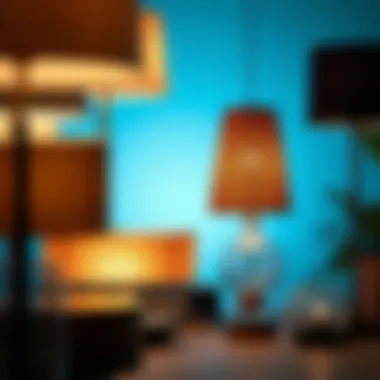

In short, understanding light floor lamp shades is essential for any homeowner or designer looking to create balanced, dynamic spaces. By grasping the significance of shades in both form and function, you can make informed choices that reflect your aesthetic values and practical needs.
Varieties of Materials Used
Light floor lamp shades come in a variety of materials, each offering its unique aesthetic appeal and functional benefits. The choice of material often defines the overall ambiance of a room, the quality of light emitted, and the style that resonates with personal taste. Understanding the characteristics of different materials can help homeowners and designers select the most suitable lamp shades that elevate their interiors while serving their practical purposes.
Fabric Shades
Fabric shades are among the most popular choices for floor lamps. They bring warmth and texture to a space, making them ideal for creating a cozy atmosphere. The variety of colors and patterns available allows for immense versatility. From cotton to linen, fabric shades come in many forms, each with distinct light diffusion properties.
- Benefits:
- Softens the light, providing a more inviting experience.
- Available in various prints and weaves, adding visual interest.
- Often more affordable compared to other options.
However, it's important to consider how fabric can absorb dust and emit a faint odor over time, requiring regular cleaning to maintain their appearance. They can easily complement both modern and traditional aesthetics, seamlessly fitting into living rooms, bedrooms, and even study areas.
Glass Shades
Glass shades exude a timeless elegance that can drastically change the look of a floor lamp. Whether frosted, clear, or colored, glass shades are often celebrated for their ability to enhance light quality. A clear glass shade provides a more direct light, making it ideal for task-oriented spaces, while frosted varieties diffuse light beautifully.
- Benefits:
- Reflects light efficiently, brightening up a room.
- Sturdy and durable, typically requiring less maintenance.
- Available in multiple shapes and designs, from globe to bell shapes.
These shades can add a touch of sophistication to any room. However, they’re often heavier than fabric shades and can be prone to breaking if mishandled. Choosing glass may also entail more careful consideration of the installation process, as improper support could lead to accidents.
Metal Shades
Metal shades are an increasingly popular choice for contemporary and industrial-style interiors. They offer a sleek aesthetic that speaks to minimalism and durability. With materials like aluminum, brass, or even copper, metal shades have the potential to command attention and serve as focal points in their own right.
- Benefits:
- Strong and long-lasting; can withstand daily use without damage.
- Provides a unique look with reflections that can alter the room’s vibe.
- Often equipped with a variety of finishes, from matte to shiny.
Despite their benefits, metal shades can sometimes give off harsh light, which may not be ideal for every setting. In such cases, it might be helpful to pair metal shades with dimmable bulbs or translucent inner liners to soften the output. Additionally, some designs incorporate ventilation holes to prevent overheating, a feature worth considering for safety.
Choosing the right lamp shade material is not just about aesthetics; it's about crafting the mood and functionality of the space.
Design Aesthetics
The design aesthetics of light floor lamp shades play a pivotal role in defining a space's ambiance and character. Unlike mere lighting fixtures, these shades contribute significantly to the visual narrative of a room. Their shapes, colors, and materials can complement or contrast with existing decor elements, influencing how a space feels and functions. Thoughtful selection ensures that a lamp doesn't just illuminate a corner but becomes a focal point that encapsulates the homeowner's style.
Not only do shades dictate light diffusion, determining whether the glow is soft or stark, but they also express personal taste. For example, a sleek, monochrome minimalistic shade can evoke a sense of tranquility, while a vibrant-colored shade might inject energy into a space. The right aesthetic complements the furniture and accessories, creating a harmonious environment.
Modern Minimalism
Modern minimalism in lamp shade design emphasizes simplicity and functionality. Think clean lines, understated elegance, and a color palette that often leans towards whites, blacks, and grays. This approach aligns well with contemporary decor trends seeking to eliminate visual clutter and promote calmness. Shades made from materials like frosted glass or streamlined metal can serve this aesthetic beautifully.
Many homeowners gravitate towards minimalistic shades to create open spaces that feel more expansive. For instance, a tall floor lamp with a simple, cylindrical shade can illuminate a reading nook without overwhelming it. The understated nature of these shades allows them to seamlessly blend into various settings, presenting versatility for those experimenting with decor themes. In this sense, minimalism might seem mundane to some but it's anything but – it celebrates the beauty of nothingness, letting the other elements shine.
Vintage and Retro Styles
Vintage and retro lamp shades bring a sense of nostalgia and warmth into contemporary homes. These shades echo design trends from past decades, often featuring intricate patterns, warm tones, and lavish textures. An example of this could be a 1960s-inspired shade adorned with botanical prints or a geometric design that recalls the boldness of the era.
These styles often spark conversations. A vintage lamp, say from the Art Deco period, can act like a time capsule, drawing the eye and prompting stories about its origins. Home decorators who favor retro aesthetics will commonly incorporate such pieces to create a haven that feels both lived-in and inviting. Here, design choices reflect a love for arts, craftsmanship, and a touch of history, enriching the overall decor.
Artistic and Sculptural Forms
Artistic and sculptural lamp shades represent the merging of form and function; they are where utility meets artistry. Such designs challenge conventional ideas of what a lamp can be, transforming it into a piece of art. From avant-garde shapes to eye-catching materials, these lamps often take on forms that invoke curiosity and draw admiration.
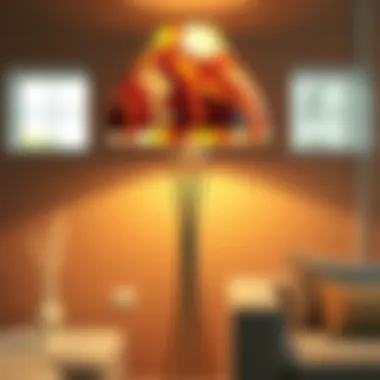

For instance, a lamp shade that resembles a twisting ribbon may not just provide light but can become a centerpiece that defines a room’s identity. Homeowners who embrace this style often appreciate statements over mere functionality, celebrating creativity and unconventional beauty. However, choosing an artistic shape requires a keen eye, as it should resonate with the existing atmosphere without feeling like it's trying too hard to impress.
"A lamp isn't merely a source of light; it can also highlight creativity, emotion, and a love for style."
In summary, exploring design aesthetics in light floor lamp shades reveals an intricate relationship between personal expression and design principles. By understanding the distinct characteristics of modern minimalism, vintage, retro styles, and artistic forms, homeowners and decorators can elevate their spaces effectively.
Functionality and Use Cases
The functionality of light floor lamp shades extends far beyond mere aesthetics. It's a critical element that influences the way a space is experienced. When selecting lamp shades, understanding their practical applications can effectively guide homeowners and designers in making choices that resonate with their daily needs and the intended ambiance of their rooms. Each shade serves not just to diffuse light, but also to define how that light interacts with its environment, impacting mood, productivity, and comfort.
Task Lighting
Task lighting is all about precision. We need it when performing activities that require clarity and concentration, like reading, working on hobbies, or even highlighting certain features in a room. Choosing the right floor lamp shade for task lighting is essential, as it can make or break the functionality of the light.
When it comes to shades used for task lighting, consider options that are designed to focus light directly. For instance, a shade with a narrower opening can funnel light downward, preventing it from scattering unnecessarily. Materials like glass or a hard fabric could serve to direct light more efficiently. If one is working on intricate tasks, a shade that allows for brighter intensity can be very helpful. Here are a few considerations for task lighting:
- Light Direction: An adjustable lamp or one with a directional shade can tailor the lighting to your liking.
- Brightness Levels: LED bulbs with adjustable brightness can offer versatility for varying tasks.
- Color Temperature: A cooler color temperature can be stimulating during work, while a warmer hue can bring relaxation during the evening.
Ambient Lighting
On the flip side, ambient lighting is the glue that binds a room together. It's all about achieving a warm, inviting atmosphere that's comfortable for both relaxation and socializing. Here, the choice of lamp shade plays a crucial role in light diffusion and overall room ambiance.
A well-designed floor lamp shade for ambient lighting promotes an even distribution of light throughout the space, softening harsh shadows while creating a cozy feel. Here’s what to keep in mind when selecting shades for this purpose:
- Shade Size: Larger shades can cast a wider pool of light, ideal for bigger spaces.
- Material Choice: Fabric shades are excellent at diffusing light softly, whereas glass shades may produce a more direct effect.
- Color Influence: Light-colored shades can help maximize brightness, whereas darker shades can add intimacy and warmth to a room.
Decorative Lighting
Finally, decorative lighting is where creativity meets functionality. It's about making a statement and demonstrating personality through design. Floor lamp shades in this category might not only illuminate but also add an element of art to the room.
With decorative lighting, lamp shades offer an opportunity for expression. An intricately patterned shade can become the focal point in any space, transforming the ordinary into the extraordinary. When selecting shades for decorative purposes, consider the following:
- Unique Shapes: Sculptural designs can add depth and interest when viewed from different angles.
- Color and Pattern: Bold colors or intricate patterns can function as conversation starters.
- Mixing Styles: Combining different styles can enhance visual intrigue, making your space feel eclectic and inviting.
“A lamp shade is not just a cover; it’s a means to express who you are.”
Selecting the Right Shade
Choosing the right floor lamp shade can significantly change the atmosphere and functionality of a space. Not only does it affect lighting, but it also contributes to the overall aesthetic appeal of the room. This decision is especially significant for homeowners and interior designers who aim to create harmonious living environments. When selecting a shade, key elements such as size, color, and compatibility with surrounding design styles should be taken into account. Each factor contributes nuances that can help achieve both practical and visual objectives.
Size Considerations
Size is paramount when it comes to selecting a lamp shade, as it will determine how effectively a lamp can serve its purpose. A shade that’s too small may result in a harsh light that does not meet the user's needs. Conversely, an oversized shade can overwhelm the space, creating an awkward or cramped appearance. Think of the room’s proportions and the standard height of furniture. For instance:
- A tall shade on a low lamp can make the light seem stunted and unattractive.
- A short shade on a high lamp might fail to disperse light effectively.
Measuring the height and diameter of the intended space can help immensely. Generally speaking, keep in mind a rule of thumb: the top of the shade should align with the eye level when seated. This practice not only ensures adequate illumination but also enhances the eye comfort in the room.
Color and Light Diffusion
The color of a lamp shade plays a dual role; it’s visually appealing while also influencing how light is emitted. Lighter shades diffuse illumination evenly, casting a soft glow that’s welcoming and soothing. In contrast, darker shades can create intimate atmospheres. Key points to ponder:
- White or off-white shades tend to allow for maximum brightness and are versatile across styles.
- Colored or patterned shades can introduce character and flair, making a bold statement.
When choosing colors, also consider the warmth or coolness of the light bulb. A warm tone can enhance the effect of a light shade in beige or soft pastels, while a cool tone can highlight bold colors like greens or blues, allowing them to truly pop.
Style Compatibility
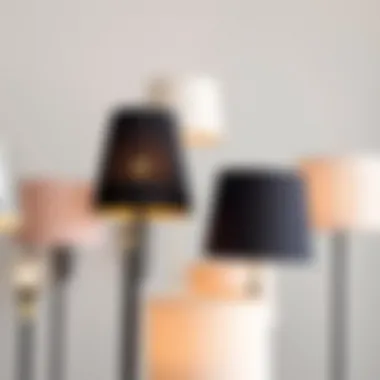

A lamp shade should harmonize with existing decor instead of clashing with it. Style compatibility entails considering both the shade's overall shape and the material it’s made from.
- Does your room lean towards modern minimalism? A sleek metal or simple fabric shade may fit snugly.
- If your space breathes vintage charm, a distressed finish or a playful pattern could enhance that nostalgic vibe.
Before making a final choice, assess surrounding decor elements. For example:
- Form: A geometric shade works well in contemporary settings.
- Material: Soft fabrics can soften stark lines in a room full of hard edges.
- Color Palette: Ensuring the shades echo or contrast purposefully with dominant colors can make a difference.
"Ultimately, the art of selecting a shade lies in balancing functionality with aesthetic appeal, ensuring that every room feels complete and thoughtfully designed."
By giving careful thought to size, color, and style compatibility, you can ensure the chosen lamp shade not only illuminates your space but also elevates its character.
Installation and Maintenance
Today’s light floor lamp shades do more than just keep the bulb hidden; they play an essential role in defining a room's style and functionality. Understanding the proper installation and maintenance of these shades ensures they not only look good but also perform optimally. Whether you’re a homeowner seeking to revamp your space or an interior designer focused on perfecting details, taking the time to consider installation and care can make a significant difference.
Installation Tips
When setting up your floor lamp, there are some key elements to keep in mind. Here are a few tips to make the installation process smooth:
- Choose the right height: Generally, lamp shades should be positioned to direct light where it is needed most. Aim for the shade to sit at eye level when seated; this ensures the light isn't too harsh and creates a soft ambiance.
- Avoid blocking the light source: Ensure that the shade doesn’t completely enclose the bulb. A slight gap helps avoid overheating and enhances light diffusion, making the room feel more open.
- Secure attachments: Double-check that all screws or connections are firmly in place. A wobbly shade can throw off the balance, impacting both style and safety.
- Consider compatibility: When buying a lamp shade, ensure it matches with the base of your lamp regarding size and fitting. An incompatible pair can lead to mishaps or aesthetic mismatches.
Cleaning and Care
To prolong the life of your lamp shades and maintain their appearance, regular cleaning is essential. Dust and dirt can accumulate quickly, dulling their shine and affecting light quality. Here are some practical cleaning pointers:
- Dust Regularly: Use a soft microfiber cloth to gently wipe over the surface of the lamp shade at least once a week. This habit keeps dust bunnies in check and maintains brightness.
- Spot Cleaning: If you spot stains or marks, consider using a mild detergent mixed with water for fabric shades. For glass or metal, a nontoxic cleaner works wonders. Just remember to avoid harsh chemicals that may scratch or damage the surface.
- Handle with Care: When cleaning, remove the shade if possible to clean all surfaces effectively. If not, be cautious around any delicate parts to avoid breaking or bending them.
- Inspect for Damage: Regularly check for wear and tear. If you notice fraying edges or cracks, it might be time for a replacement.
Taking care of your lamp shades should be part of your general home maintenance routine. Like any other feature in your space, they benefit from a little TLC to keep shining bright.
By following these practical tips, the installation and maintenance of light floor lamp shades can be a straightforward process that enhances both aesthetic appeal and functionality.
Innovative Trends in Lamp Shades
The world of lighting design is evolving at a rapid pace, bringing with it a slew of innovative trends, particularly in lamp shades. Understanding these trends is crucial for homeowners and decorators looking to stay ahead of the curve. Innovative lamp shades are not only functional but also redefine how spaces feel and how they are lit. In this section, we will look at two prominent trends: the integration of smart lighting technology and the use of sustainable materials. Both these elements offer unique benefits and should be considered when choosing the right lamp shade for any space.
Smart Lighting Integration
The rise of smart technology has revolutionized various aspects of home decor, and lamp shades are no exception. Smart lighting integration offers functionality that goes beyond simple illumination. With the ability to control brightness, color temperature, and even patterns via smartphones or smart assistants, today's lamp shades can greatly enhance mood and utility.
- Customization: Many modern lamp shades come equipped with features that allow homeowners to customize lighting to suit different activities or moods. For instance, you might want bright light for reading and a softer ambiance for relaxing.
- Energy Efficiency: Smart light bulbs have low energy consumption compared to traditional bulbs, which can lead to significant savings on electricity bills. They also offer longer life spans, which means you won’t be replacing bulbs as frequently.
- Convenience: Imagine being able to adjust your lamp shades from your bed or while cooking in the kitchen. With voice commands or just a tap on your screen, this convenience supports a lifestyle that values comfort and ease.
Moreover, having a smart lighting setup can seamlessly integrate into established home automation systems, allowing for personalized and intuitive overall home management. Smart lighting can be dimmed, brightened, or turned on and off based on your schedule—all enhancing the practicality and usability of floor lamps.
Sustainable Materials
With an increasing focus on environmental impact, the trend of using sustainable materials in lamp shades has gained momentum. As consumers become more aware of their carbon footprints, the demand for eco-friendly options has surged. Here’s why using sustainable materials for lamp shades is essential:
- Reduced Environmental Impact: Materials like bamboo, recycled glass, and organic linens minimize harm to the environment, offering a greener alternative to conventional materials.
- Aesthetic Appeal: Sustainable materials often come with a unique charm and character. For example, bamboo shades have a natural finish and allow light to filter through beautifully, creating a warm, inviting atmosphere.
- Market Differentiation: Using sustainable materials in your lamp shades can set your decor apart. In an era where sustainability is increasingly valued, having unique, eco-conscious lighting can impress guests and contribute positively to social dialogues surrounding home decor.
End
As we wrap up our exploration of floor lamp shades, it’s crucial to emphasize the significant role they play in home decor and lighting optimization. Choosing the right lampshade isn't just about aesthetics; it directly influences the atmosphere and functionality of a space.
Final Thoughts on Selection and Style
Selecting the proper shade requires careful consideration of several factors. First off, the material can drastically affect the quality and type of light emitted. For example, fabric shades may provide a softer glow, perfectly suitable for creating an inviting atmosphere in living areas, while glass shades can emit a more direct, focused light, which is ideal for task lighting scenarios.
Beyond function, colors and patterns on the lampshade can either enhance or clash with existing decor. It's essential to match the shade design with overarching themes in your home. A sleek, modern shade can blend seamlessly in a minimalist space, while a bold retro piece could bring a splash of character to more eclectic themes.
Don't overlook the size! The height and width of the shade must harmonize with both the lamp body and the surrounding furniture. Too large can overshadow a room's design; too small may disappear into the background.
When styling, remember that the lampshade is not merely a light source but a design element that can set the mood. Think of it as a jewelry piece; it’s the little things that elevate the overall aesthetic. Aim for a cohesive look by ensuring that the shade complements other decorative elements.
In essence, the journey into selecting lamp shades should be as rewarding as the ambiance they create. By understanding the interplay of material, color, and design, homeowners can curate a lighting solution that not only meets practical needs but also articulates personal style beautifully. Embrace the diversity in lamp shades to enrich the tones and textures of your living spaces.













